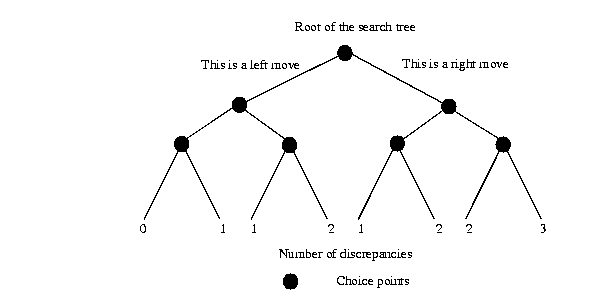
| Overview | Group | Tree | Graph | Index | Concepts |

Instances of this class represent nodes in the search tree of a parallel
search. Most of its member functions access information of use to node
evaluators. Node evaluators are documented in the class IlcNodeEvaluator.
The following figure illustrates a search tree consisting of its root node and choice points. Its maximum or-depth is three. It shows the number of discrepancies at the leaves. A discrepancy corresponds to the or-depth of that search node minus its left-depth.

See Also:
| Constructor Summary | |
|---|---|
public | IlcSearchNode() |
public | IlcSearchNode(IlcSearchNodeI * impl) |
| Method Summary | |
|---|---|
public IlcFloat | getBitsetValue(IlcInt start, IlcInt length) const |
public IlcInt | getDepth() const |
public IlcSearchNodeI * | getImpl() const |
public IlcInt | getLastDiscrepancyDepth(IlcInt offset) const |
public IlcInt | getLeftDepth() const |
public IlcInt | getRightDepth() const |
public IloSolver | getSolver() const |
public IloSolverI * | getSolverI() const |
public void | operator=(const IlcSearchNode & h) |
| Constructor Detail |
|---|
This constructor creates an empty handle. You must initialize it before you use it.
This constructor creates a handle object from a pointer to an implementation object.
| Method Detail |
|---|
Node evaluators use this member function. It first converts the path from the root to the
node into a bitset, where 0 (zero) is a left move and 1 (one) a right
move. Then it extracts from this bitset a sub-bitset starting from the position indicated by the
parameter start and extending. It then converts this extracted bitset into an integer,
using the convention that the least significant bit is to the left (corresponding to the choice
points closer to the root of the search tree). This member function then casts this integer into
a IlcFloat value and returns it.
Node evaluators use this member function. It returns the or-depth of the invoking search node.
This member function returns a pointer to the implementation object of the invoking handle.
Node evaluators use this member function. It returns the or-depth of a particular node
in the search tree; that node is the one located at offset number of right moves
along the path from the root of the search tree to the invoking node.
Node evaluators use this member function. It returns the number of left moves in the path starting from the root of the search tree to the position of the invoking node.
Node evaluators use this member function. It returns the number of right moves in the path starting from the root of the search tree to the position of the invoking node.
This member function returns the solver that the invoking node belongs to.
This member function returns the implementation of the solver that the invoking node belongs to.
This operator assigns an address to the handle pointer of the invoking object. That address is the location of the implementation object of the provided argument.